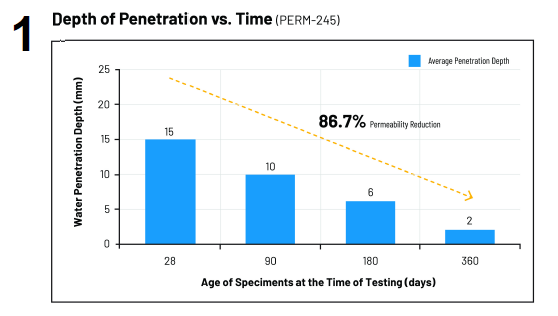ASSESSING LONG-TERM CONCRETE PERMEABILITY:AN INDEPENDENT TEST REPORT SUMMARYON XYPEX ADMIX C-SERIES PERFORMANCE

The durability of concrete in water-exposed environments is a fundamental concern in civil engineering. Understanding how permeability changes over time is critical for ensuring the longevity of infrastructure. This article summarizes an extensive six-year test report (PERM-245) analysing the permeability behaviour of concrete
treated with Xypex Admix C-Series over a 360-day period. The scale of this study—featuring 225 test sets from 160 monitored projects across five European countries—provides a uniquely comprehensive perspective on long-term concrete permeability.
Scope and Scale of the Study
What distinguishes this independent study is its rare scale and statistical depth. The
6-year study analysed 225 test sets originated from 39 concrete production plants
spread across 5 European countries. Such breadth ensures the findings capture a wide array of real-world conditions, thereby offering a reliable reference for engineers and specifiers. By examining concrete at various ages—commonly 28, 90, 180, and 360 days—the data illuminate how permeability evolves well beyond the conventional 28-day assessment point.
Methodology: Evaluating Permeability Under EN 12390-8
All tests were conducted according to
EN 12390-8, which measures water penetration depth by subjecting hardened concrete specimens to a constant water pressure of 0.5 MPa (≈ 50.99 m water head or 72.5 psi) for
72 hours. The specimens included:
- 150mm (≈5.90 in) cubes
- 150mm (≈5.90 in) cubes x 200 mm (≈11.81 in) cylinders.
Following standard practice, specimens were initially cured in water (as per EN 12390-2) until the first test age (often 28 or 90 days). From that point onward, samples were stored with the tested surface submerged in approximately 30 mm (≈1.18 in) of water, mimicking real-world conditions where concrete can be exposed to moisture, pressurized water, or groundwater over extended periods.
Findings: Progressive Reduction in Permeability
Water Penetration Depth Over Time
Analyses from the collected data reveal that permeability consistently decreases as the concrete matures. In many cases, successive tests at 28, 90, 180, and 360 days showed the depth of water penetration diminishing significantly: (see image 1)
These results reflect how Xypex Admix C-Series catalyzes further densification of the concrete matrix over time. As the admixture reacts with water, it creates insoluble crystals that block capillaries, pores and microcracks, thereby reducing water ingress even beyond typical 28-day benchmarks.
Zero-Penetration Results
One unexpectedly beneficial consequence of the tests is the proportion of specimens achieving 0 mm (0 in) (no measurable water ingress). Across 225 tests:
- 28 days: ≈3% of specimens registered zero penetration.
- 90 days: ≈21% showed zero penetration.
180 days: ≈44% reached complete impermeability. - 360 days: ≈57% exhibited no water ingress.
This underscores the Xypex’s continuous crystallization and self-healing process, which points towards an extended service life.
Implications for Concrete Durability
By incorporating data from multiple production facilities and job sites across varying environments and concrete types, this study reinforces confidence in the long-term effectiveness of Xypex Admix C-Series for reducing concrete permeability. The gradual and sustained decrease in water ingress—observed at 28, 90, 180, and 360 days—demonstrates the continuing reaction of Xypex Admix C-Series within the concrete matrix.
These findings suggest that specifying additional test ages beyond the
standard 28 days can provide a clearer picture of a concrete mixture’s long-
term performance—particularly for water-retaining or below-grade structures, where ongoing exposure to moisture is a critical design consideration.


Need help with your waterproofing challenge?
Get in touch